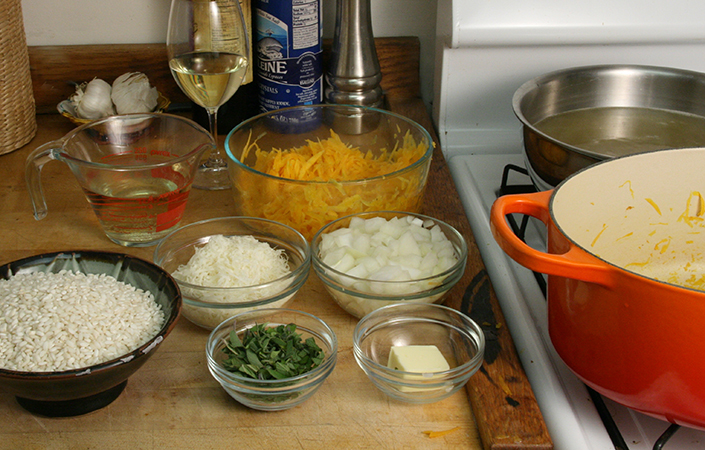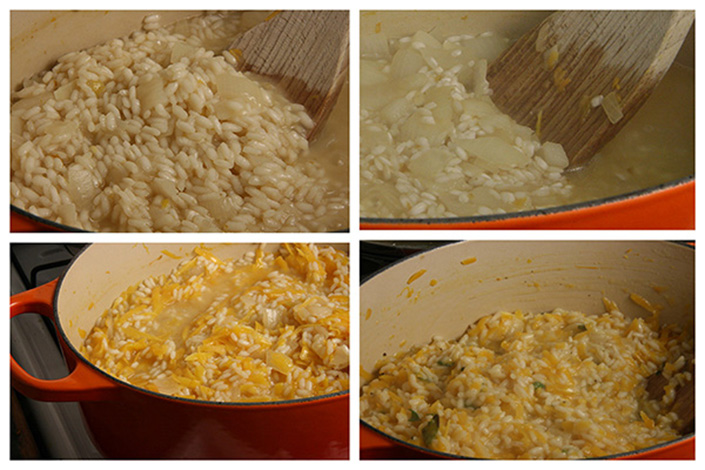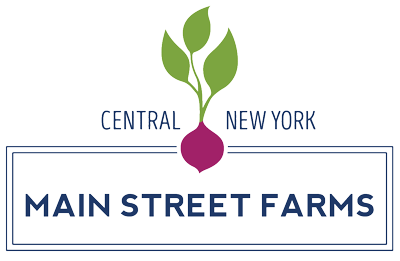
Butternut Squash, sage, and parmesan are a perfect late fall/early winter combination. This dish makes an excellent main course with a simple salad or a rich side dish. Add it to your Thanksgiving table or serve it with leftover turkey. Don’t let the title of this post scare you-you might think that risotto is only for restaurant chefs and fancy home cooks with a lot of time on their hands, but I’m about to ruin that myth for you. After you make risotto a few times you’ll see that it’s just a simple ratio of white wine, stock, and rice with cheese and sautéed veggies and/or meat added at the end. Anyone can make it, it’s basically cheesy rice. That said there is a little more active cooking time than some recipes and quite a lot of stirring. I always find that it’s best to make risotto with a partner (take turns stirring!) and your favorite beverage nearby. The key to making risotto is to have everything ready and organized before you start, that way you’re not running away from the stove to find the cheese grater-the grated cheese is right next to you ready to go into the pot. Take 5 minutes to set up your mise en place and you’re ready to go.

A few key tips will make the process go smoothly. Here everything is measured and ready to go in the pan, the simmering stock is right behind the risotto, and I have a large pan with tall sides that completely covers the burner to cook the risotto. The shredded squash is pre-cooked (I barely rinsed the pan as you can see) and ready to stir in at the end. After you sweat the onions the rice is briefly toasted, and then the stirring begins! Start with the wine, and after it’s absorbed add the stock one cup at a time gently stirring until it is completely absorbed before adding the next cup. Here is the rice in stages: just after the wine, adding the stock, and near the end of cooking. You’ll know the risotto is close to done when you can see the grains of rice starting to swell. Try it a few times throughout cooking, when it’s al dente it’s finished and ready for the veggies, cheese, and butter.

The cooked shredded squash is added just before the last cup of stock goes in. Use your judgement, after a few times making this you’ll know exactly when it’s ready. The recipe calls for 6-8 cups of stock, because just like baking it’ll be a little different every time. Stir gently-give your arm and the rice a break every once in a while!

Butternut Squash Sage Risotto
serves 8
1 medium butternut squash shredded (about 1 medium butternut)
1 tablespoon olive oil
2 cups arborio rice
6-8 cups chicken or veggie stock
1 cup dry white wine
1/2 onion finely chopped
2 tablespoons butter, divided
1 cup grated parmesan
1/4 cup finely chopped sage leaves
salt + pepper
Cook the squash. Heat olive oil over medium heat and sauté squash for 8-10 minutes until softened.
Set-up. Bring chicken or vegetable stock to a simmer on the back burner. Keep simmering over medium low heat throughout cooking time. Place pan to cook risotto on burner directly in front of stock. Measure remaining ingredients and line up next to stove. (Rice, wine, cooked squash, chopped sage, grated cheese, butter)
Melt the butter over medium heat. Saute onion until translucent. Add dry rice and toast in the pan until shining, stirring gently. Add wine and gently stir until all the wine is absorbed. Once wine is absorbed, add stock one cup at a time, gently stirring until each cup is absorbed. Just before rice is finished, add the squash and the final cup of stock. When stock is totally absorbed and rice is al dente, remove from heat. Add cheese, butter, and sage. Serve at once.
Notes. This recipe can easily be halved to serve 4, if making a half batch add stock 1/2 cup at a time. Risotto is best straight from the stove to the table, but if it sits for a bit before serving warm gently and add a little stock to reheat. Leftover risotto can be reheated, or formed into patties, coated in bread crumbs, and pan fried.


